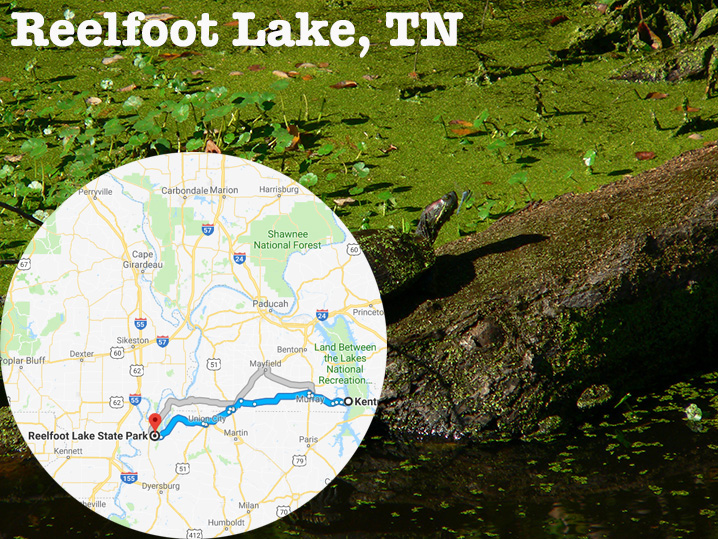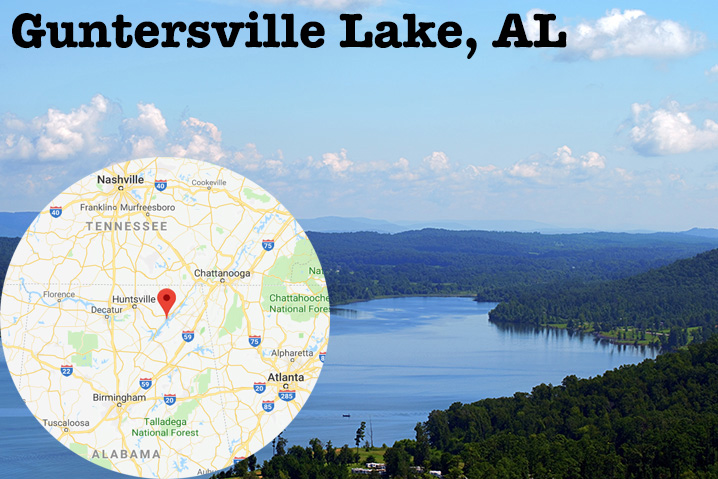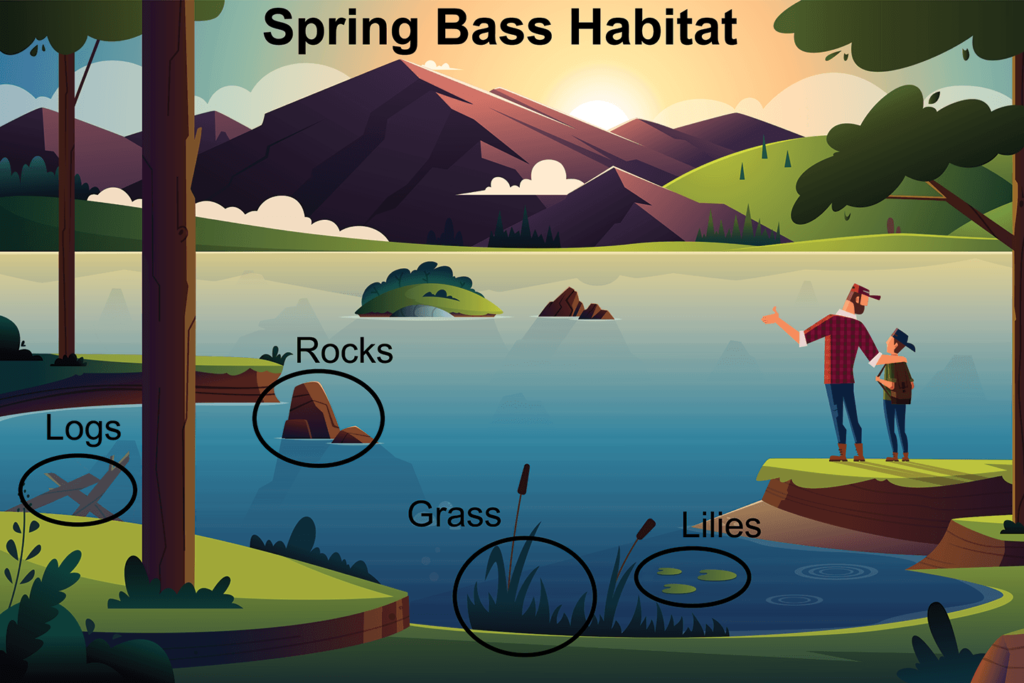Bass are some of the most iconic fish in the US, and there’s no better time to target them than spring. Warming waters turn even the laziest Largemouth into an aggressive lake monster. This makes the spring Bass fishing season the most exciting time to wet a line.

Spring is spawning season for Bass. This means aggressive fish, shallow water, and a whole list of challenges and opportunities. Today, we’re going to guide you through the essentials. Whether you’re looking to up your game or land your first fish, we’ll cover all you need to know to reel in a monster.
Spring Bass Fishing Spots: What to Look For
Any knowledgeable angler will tell you that to catch a fish, you need to think like it. Bass have spent most of their winter days foraging the deep waters. As the spring kicks in, they’ll start moving to spots that are rapidly warming up. They’re eager to spawn and set up their nests in shallow water, especially spots with structure.
This means you should look for fallen trees, grass, rocks, water lilies – anything that can serve as a cover. It can sometimes be hard to spot these places, but with the right electronics or a bit of research, you can find a real prize.
However, Bass are always on the run and can get unpredictable, especially if the weather is finicky. One day can be all bite and fight. Come to the same spot the next day, and you get skunked. You need to be patient and experiment with the fishery. As a rule of thumb, fish with faster lures and patterns on warm spring days and swap these for slower-moving baits on colder days.
Come Rain or Shine: Best Weather for Bass
When fishing for pre-spawn Bass, the weather can really help you out. On cloudy days, Bass will move around the lake. You’ll have better chances of catching them as they explore the shallower parts as well.
Another element that plays to your advantage is rain. Bass tend to be more aggressive when it’s raining and leave their cover to feed, so grab a good pair of boots and go stand in the rain. Spring showers also make it more difficult for Bass to spot you.
Lastly, don’t shy away from the breeze. The wind will spur bait fish to congregate in cover and Bass won’t skip a meal. On windy days, the fish will move to shallower parts. You may find it tricky to navigate a boat on a day like this, but on the plus side, the water movements caused by the wind will make it harder for the Bass to spot your boat.
The Three Stages of Spawning
Everything in spring revolves around the spawn. Whether fish are looking for a mate, holed up on their nests, or moving back out onto the lake, understanding their goal will help you achieve yours. Here’s a brief summary of the three stages of the spring Bass spawn: pre-spawn, spawn, and post-spawn.
Early Spring Bass Fishing

The early spring can be a hit and miss, especially if the snow and ice continue into April. Bass are sensitive to temperature changes and will stay alert in order to find the spawning grounds.
However, the cold front will still keep them near the depths – they won’t risk venturing into cold shallows. What Bass do in that case is look for deep waters near shorelines where they can find secluded spots such as rocks and weeds.
Once the weather improves, Bass will head to the shallows. They will stick to areas with access to deeper water, though, to avoid sudden drops in water temperature. Because of this, transition areas like points and coves are a good place to look.
Mid-Spring Bass Fishing

Depending on where you live, the spawn normally kicks off in the middle of spring. Bear in mind, though, that not all Bass spawn at the same time. You can target females waiting for the males to set up spawning beds, as well as fish already holed up on their nests.
Bass are at their most aggressive immediately before or during the spawn. They’re fighting for their chance to mate and won’t let anything stand in their way. You’ll find most of the action in the shallows during this time. However, that’s also where you’ll find the most fishing pressure. If it’s too busy, look for fish staging in deeper water too.
Once the fish have spawned, the males will hole up on their nests, and the larger females will move out to the edges of the spawning zones to rest. This makes them easy to find, but hard to tempt. They’re either exhausted or guarding the nests, and will mainly bite out of annoyance or the perception of a threat.
Late Spring Bass Fishing

Once the spawn’s over, the fish are back out on the hunt. This can be a great time to target large females, as they’re angrily feeding up after the efforts of spawning. What makes this even better is the arrival of smaller fish like Bluegill, who move in to spawn after the Bass are done.
Ambush is the name of the game here. Bass will lurk around cover, waiting to jump out at unsuspecting fish. Use this to your advantage, pitching deep into cover with weedless lures. This will also help you escape the strong fish pressure of late spring.
As spring turns to summer, water temperatures stabilize and Bass start to leave the shorelines. This signals the end of the spring fishing season. However, you can still get in some last-minute trips if you hit the water early, before the morning sun warms the water.
Spring Bass Fishing Lures
When it comes to lures, there’s no cookie-cutter solution. Pack a variety as you’ll probably need to vary your tactics to stand a chance. You’ll also need to factor in the weather and the season (pre-spawn, spawning, post-spawn). But before you do all that, let’s have a look at the most common lures used in catching spring Bass.
Spinnerbaits

What are spinnerbaits for? Creating vibrations and noise that will make the Bass think that prey is near. Bass rely heavily on their sense of hearing, so you’ll want to create some noise, more so if you’re fishing calm waters with little to no wind.
Luckily, spinnerbaits are a pretty versatile lure. The metal blades attached to them come in different shapes and sizes. Some anglers also trim the skirt of the lure so that it doesn’t get tangled and wound up.
On a calm day, you can retreat the lure more slowly, but when there’s wind, make sure to start reeling in the second your lure is in the water. You need to make a splash and the blades’ shiny appearance will entice the fish. Yo-yoing (pulling the lure up and then dropping it) should also produce a good effect and get the Bass going.
Jerkbaits

If you want to winch up a pre-spawning Bass, you need to work jerkbaits. They’re common weapons of choice for a good reason. Bass monitor the water temperature closely, making sure to stay in warmer parts. You’ll need jerkbaits to work both the clean shallow waters and grassy patches.
Be sure to try out various jerkbait presentations. The rhythm can be key to enticing Bass, and if you’re fishing during a cold front, you’ll want the pause between jerks to be longer. Also, keeping slack in the line is essential to successful jerk movements. If you’re fishing on a breezy day, use long casts and bigger lures that will attract bigger fish.
Jigs

For anglers who don’t mind taking things slow, working jigs to imitate Crawfish can produce some real magic. Pre-spawn fish will be moving from deeper waters to spawning grounds, so the key is to jig slowly and near the bottom. If the weather allows it, you can just drag the bait over the bottom and slowly retrieve it.
When looking for Bass in more secluded waters and grass laydowns, you’ll want to thread your jig trailer to the jig body until it’s leveled with the hook point. Make sure that your jig trailer is free of excessive appendages so that you can easily cast and retrieve it from sheltered waters.
In case of open and deep waters, you can go ahead and chunk the jig trailer. Use soft-plastic crawfish with large flappers and appendages. Chunking the trailer lets your jig have a bigger profile and a lot more movement. In grassy spots, this is going to get you some real beasts.
Also, mind the color – it’s important to pay attention to the weather, the amount of light outside, and the turbidity of the fishery. Brownish hues will work in stained water, while greenish colors work like a charm in clean waters.
Best Spring Bass Fishing Spots Around the States
Before we jump into the specific spots, bear in mind that this list isn’t exhaustive. Bass fishing is awesome throughout the States, and there are thousands of bodies of water that can produce stunning catches. That being said, the places on this list are pretty tough to beat.
1. Lake Seminole, Georgia

Perched on the border with Alabama and Florida, Lake Seminole is home to some of the best Bass fishing in Georgia. You can get Largemouth worthy of the name pretty much anywhere around the almost 400-mile long shoreline.
There’s also plenty of structure in the water, with sunken logs, bushes, rocks, and grass, and some deep water pockets. This means that the fish will feel confident when looking for spawning grounds. They might even wander completely out of cover. This lets you maneuver more to get a solid catch.
2. Ross Barnett, Mississippi

This man-made reservoir is a favorite of many outdoors lovers. Wet your line here, and you’ll soon be one of them. The reservoir held the Bassmaster Classic World championship back in 1978 and is home to the Ross Barnett Open. There’s a good reason for all this: local fishing reports regularly include some seriously big specimens.
The scenery is idyllic, which makes fishing both blood-pumping and relaxing. It’s a short ride from Jackson and a nice spot for spring break. Bass will move to shallow waters and you can often find them in only a couple of feet of water. Check out the lily pads, rocks, and rubble, and you can often find females, too.
3. Lake Okeechobee, Florida

“Florida’s Inland Sea” attracts scores of anglers from across the US. Many come to the Sunshine State in search of Tarpon or Redfish, but can’t resist taking a trip to Lake Okeechobee while they’re there. They very rarely regret it.
There’s some serious action going on around here and spring months often see dozens of fish over 7 pounds. Local anglers say that you should come visit the “Big O” by late April to reel in the fish looking to spawn. Spring breakers often flock here and scout around lily pads and shallow waters with plenty of vegetation where the fish hide.
4. Lake Norman, North Carolina

Lake Norman is known as a premier dock fishing location where you can land impressive Bass any day of the year. In spring, docks serve as an excellent hideout for pre-spawn fish. Little do they know that they’re just making it easier for you.
Don’t limit yourself to the docks, though. There’s plenty of cover, so make sure to move around to find where the fish are. There are schools of Bass in the main lake, but you should also check around the creeks. Plus, the lake makes for a nice family vacation spot.
5. Reelfoot and Kentucky Lakes, Tennessee

You don’t have to be a botanist to appreciate the beauty of this scenery. Reelfoot Bass fishing is consistent throughout the year, and during their spring season, these fellas will move all over the place to find a good spot for their spawning bed.
The lake has diverse terrain, from 15′ depths to shallows. It also has island patches and trees jutting up from the water. Move around and make sure to explore these to the fullest.
Guides on Kentucky Lake have access to chunk rock banks which are a premier spot during spring days. Bass are eager to move out into the open and once the temperature goes above 55°F, you could be facing some monster fish. The key is to explore transition waters near the shallows to make the most out of your outing.
6. Lake Fork, Texas

The “Bass Fishing Capital of Texas,” Lake Fork produces big bites in the pre-spawn season. It has skinny patches with water only several feet deep where you can get a 15-pounder during the first warm days.
Make sure to look for flat coves, marshy inlets, or main lake pockets and try to spot grass where the fish can hide. The bait fish will be moving towards the warm waters and Bass rely massively on them to survive.
7. Guntersville Lake, Alabama

There aren’t many bodies of water that get Bass fishermen all hyped up, but Guntersville sure does. A stable water level, easy access to fisheries, and many public boat ramps make this lake a perfect launchpad for Bass enthusiasts and pros. In the Bass angling community, Guntersville is hallowed ground.
There are many patches of eelgrass ripe with fish and this is the perfect time to explore them. The spring Bass fishing Lake Guntersville offers is some of the hottest in the sport. A lot of the area’s guides are acclaimed Bass Masters, so if you want to try something special, why not treat yourself to a guided trip?
Spring Bass Season: The Perfect Time to Be and Angler

We could happily go on, but we’re keeping you off the water. Hopefully, you’ve learned a thing or two about how, when, and where to enjoy some epic Bass bites this spring. Now it’s time to find a fishing charter near you and start reeling in lunkers!
How do you fish for Bass in spring? What lures and bait do you opt for? If you’re an experienced Bass fisherman, what advice would you give to aspiring anglers?

